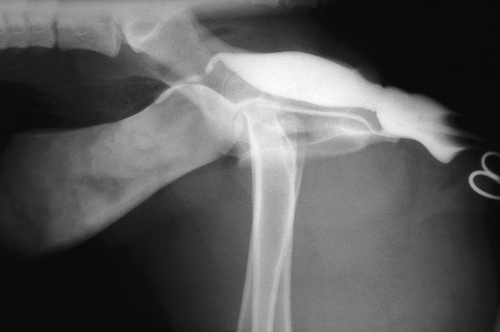Difference between revisions of "Small Animal Abdominal and Metabolic Disorders Q&A 02"
Jump to navigation
Jump to search
Ggaitskell (talk | contribs) |
|||
| (One intermediate revision by the same user not shown) | |||
| Line 1: | Line 1: | ||
| + | {{Manson | ||
| + | |book = Small Animal Abdominal and Metabolic Disorders Q&A}} | ||
| + | |||
[[File:SmAn Ab and Met 02.jpg|centre|500px]] | [[File:SmAn Ab and Met 02.jpg|centre|500px]] | ||
| Line 18: | Line 21: | ||
*Ultrasound examination of the bladder after residual air and contrast has been removed and the bladder moderately filled with sterile saline. This allows identification of ureterovesical junctions and visualization of ureteral jets from ureters entering the trigone normally. Alternatively, direct visualization of ureteral emptying with fluoroscopy. | *Ultrasound examination of the bladder after residual air and contrast has been removed and the bladder moderately filled with sterile saline. This allows identification of ureterovesical junctions and visualization of ureteral jets from ureters entering the trigone normally. Alternatively, direct visualization of ureteral emptying with fluoroscopy. | ||
*Urodynamic investigation. Stressed urethral pressure profilometry is a better predictor of continence than plain urethral pressure profilometry. Both techniques require expensive equipment and are dependent upon the technique used. Urethral pressure profilometry can provide additional useful information. | *Urodynamic investigation. Stressed urethral pressure profilometry is a better predictor of continence than plain urethral pressure profilometry. Both techniques require expensive equipment and are dependent upon the technique used. Urethral pressure profilometry can provide additional useful information. | ||
| − | |l1= | + | |l1=Urethral Sphincter Mechanism Incompetence |
|q2=This radiograph was obtained. What is your main differential diagnosis? | |q2=This radiograph was obtained. What is your main differential diagnosis? | ||
|a2= | |a2= | ||
| Line 26: | Line 29: | ||
Other common causes of urinary incontinence were ruled out by the above investigation. | Other common causes of urinary incontinence were ruled out by the above investigation. | ||
| − | |l2= | + | |l2=Urethral Sphincter Mechanism Incompetence |
</FlashCard> | </FlashCard> | ||
Latest revision as of 14:21, 26 October 2011
| This question was provided by Manson Publishing as part of the OVAL Project. See more Small Animal Abdominal and Metabolic Disorders Q&A. |
A two-year-old, neutered female Giant Schnauzer presented with urinary incontinence of several months’ duration. The dog leaked when recumbent and the severity of the incontinence varied. The dog was otherwise normal. She was spayed at 11 months old after her first season and was not incontinent as a puppy.
| Question | Answer | Article | |
| How would you investigate this dog? |
|
Link to Article | |
| This radiograph was obtained. What is your main differential diagnosis? | In this case the history, lack of specific findings on clinical and radiographic examinations, and presence of an intrapelvic bladder neck on the radiograph were highly suggestive of urethral sphincter mechanism incompetence. The dog responded well to treatment with phenylpropanolamine and subsequent colposuspension. Other common causes of urinary incontinence were ruled out by the above investigation. |
Link to Article | |
